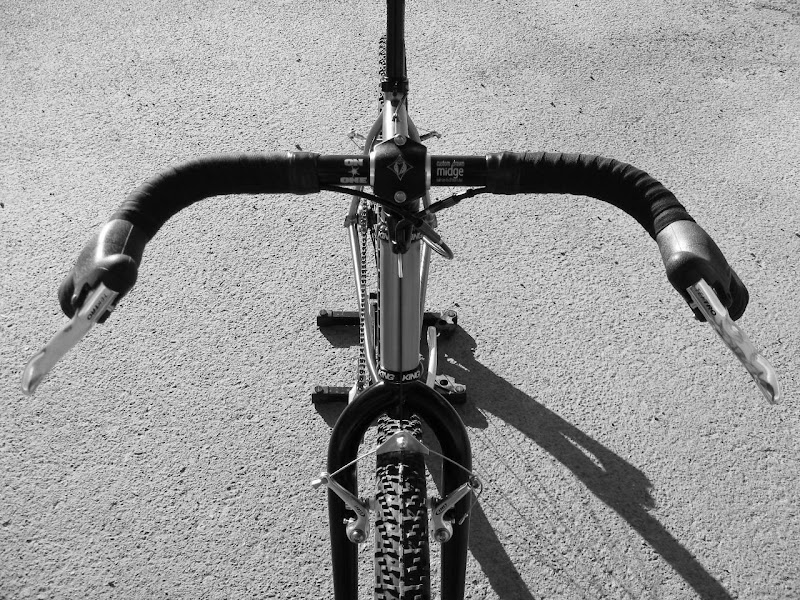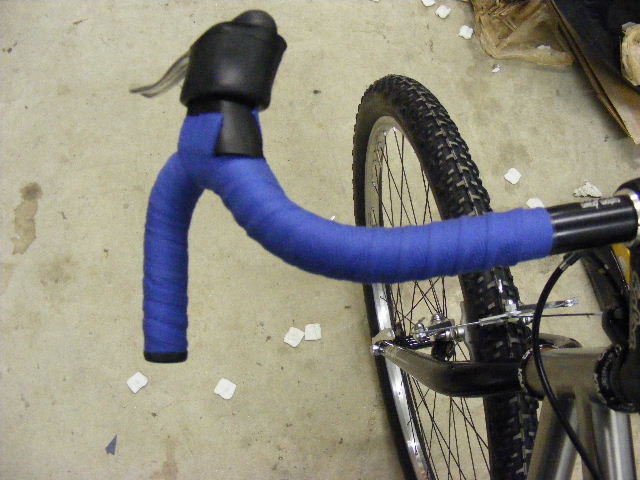This is a one-off post as I long ago promised a friend/customer to do a writeup about how I set up Power Grips. Sorry there aren't more photos...like I wrote about earlier on 5mod, our digital age doesn't take too kindly to long term accessibility, as I found with a bunch of corrupted visuals of my PG setup on my ancient shop laptop. No dice. So, text will have to suffice since I don't even have a bike put together right now.
At some point, I don't remember exactly when, I had decided that I wasn't going to use clipless pedals anymore...this after basically riding Time ATAC clipless pedals problem-free for more than a decade. I think it had to do with replacement cleats seemingly wearing out much faster while becoming more expensive at the same time. I had a few toe-in-the-water forays going clipless-less, with generally disappointing results and honestly confirmation that I was making this decision based on the love of an idea rather than really making things "better" (see also: advocacy obnoxiousness, all political "discourse", and general smug contrarian chickenheading). I would learn though - sometimes you just have to figure something out without the use of Google.
I had messed around with plain old BMX platform pedals some in Colorado and didn't really like them for steep climbing, although now I think they'd totally rule for long distance bikepacking travel, where aggression is circumvented by a long, slow burn so long as your ego allows it. Once I started riding fixed wheel everywhere, the thought of raking screw-in pins up the fleshy part of my calf or driving them into my shins like pitons didn't jive with me so well.
I then set up a standard clip-and-strap arrangement, messing around with some different variations but ultimately using Suntour XC Pro pedals, XL plastic cages, Cinelli toe straps with a laminate centre, and toe strap buttons. It was OK, I guess. I honestly didn't put enough time into really customizing things for getting my foot properly positioned over the pedal axle (those with really small or large feet will identify) or day-in-day-out comfort.
I had a couple of problems on the latter front. One was using a more traditional, smaller MTB platform pedal which really wore on me after a number of long (160+km) days in the saddle while using skate, BMX, or indoor soccer shoes. The second was that I have a rather toes-down pedaling style. This isn't that weird, lots of people do. The thing is, those people generally had cleats/plates nailed/screwed to their soles when riding their bikes big distances and/or quickly, holding their feet in a fixed position while the toe strap did its job. The result: My already hammer(ed) toes suffered like all hell on said long days as they got crammed to the end of my flexy footwear and against hard plastic.
This, as well as my friends Kent Peterson and Larry B. in Idaho, led me to where I might have been in the mid-90s: Power Grips. I assume if you're reading this you know what they are, otherwise follow the link at the top of the post.
Setting up Power Grips is just like dealing with fenders, racks, bike bags, your general position, or your general fitness...meaning: The amount of time you put into it is reflected in the results you get.
Lots of folks just bolt things together kinda sorta and with the resulting "this sucks" or "what a POS" if the universe doesn't bend to their will in an instant. Take some time to set things up better.
Here are my thoughts:
1) Shoes.
Lots of folks from the non-clipless clique trumpet the benefits of using "whatever shoes they want." This really isn't true for Power Grips. Shoe choice is important, and if your justification for doing this is to "ditch bike shoes" and you ride off-road for real...well, you're still going to need to delegate a pair of shoes for mountain bike-y action. I'll say why down the list. The fact of the matter is that sneakers of any kind are never going to replace the feel of standalone cycling shoes. Seriously, don't argue, I've ridden both a lot. Even the burliest BMX shoes feel pretty floppy compared to a "flexy" cycling shoe with a plate-backed clipless cleat. This is the biggest potential deal killer and will have most people bolting up clipless pedals no matter how good your "simple pedal" setup is, period. Remember, there's a pragmatic reason why this clipless stuff came about.
I've ridden a few different pairs of BMX/freeride shoes and while the protection is nice...they are pretty big and chunky for ingress into the pedal. Trail/mixed surface running shoes aren't much fun for ingress either, some less aggressive ones can be OK though - e.g. Saucony Grids. Some people like approach shoes for BMX platforms but I find that the surface area on a regular MTB platform is a little small for the sole flexibility. Minimalist skate shoes or retro sneakers are fine for dicking around or day rides, but they really aren't the best choice on a non-BMX platform pedal for really going a long way, especially off-road. A lot of folks like indoor soccer shoes the best amongst non-cycling shoes...Adidas Sambas in a non-long tongue iteration (not the 'Classic' ones) specifically. It's probably best though to invest in some more tour-y/commuter cycling shoes with less aggressive tread - just for the sole stiffness factor. Irony? Maybe.
2) Pedals.
I rode Suntour XC Pros for a long time. They rule, but they aren't made anymore and you don't need something so fancy. I sold all of mine after I got hurt. There are a lot of pedals that 'look' like the old Suntours. Be wary though. A lot of times the cages are flexy as hell, not while you're pedaling but in regards to rock strikes, crashes, dropping and the like. Same with the hardware holding on said cages. Often times it's not up to real rough treatment. It's safer to stay with a one piece pedal body, like on the Wellgo M142 or Velo Orange Touring pedals.
Some people have retrofitted BMX platforms or bear traps with Power Grips. I don't really dig it as the strap is at a pretty rakish angle for easy entry and the reflector holes are not in the optimum places for really using the strap properly.
One place where toe clips are nicer than Power Grips is your ease in using an externally mounted toe flip to get into the pedal. With Power Grips set up for more aggressive riding, you are entering the pedal outboard of centre and the Power Grip takes up the inner reflector mount hole. This makes adding toe flips (that are actually useful) to the pedal much harder. I just suck it up and deal with it. It takes some practice to get into them smoothly without the aid of a toe flip, especially with a boxy pedal like the aforementioned M142 that has no 'hook' of any kind. It's never going to be as easy as stepping on a clipless pedal, just saying. Remember how it was trying to get back on your bike after totally making a hash of that creek crossing? OK. Be patient and practice. Again, low-pro shoes help here. Having a pedal you can easily use on the non-strap side is good too (that's one strike against the XC Pros).
3) Power Grip setup.
I didn't figure this out totally myself, the cycling writer John Kukoda was my initial muse and then I fleshed stuff out my own way.
First, since I have largish feet (Euro 48), I only buy the XL Power Grips (the long ones for winter boots) and I only use the bolt-through hardware (no "micro-adjust" or any such thing). You will need the long ones unless you have really small feet, and even if you do the long ones allow things to be more 'custom'. The hardware that comes with Power Grips is OK, but I don't really like Phillips head screws...so I replace the hardware with button head stainless bolts. In case you are wondering...the usual weight of this kit is approximately [DARK MATTER HEAVY] grams.
I mount up the strap plate on the front of the pedal as inboard as I can, mainly because of my big feet. You can even double up the plate (bringing things to [DARK MATTER + MERCURY HEAVY] grams) to prevent bending in case of rock collision. For most that is overkill though.
I run my straps upside down in order to hide the giant logo. Bolt up the single holed side of the strap to the inside rear reflector hole. With just the rear of the strap on, I install the pedals on the bike. This allows me to place my foot on the pedal where it is actually going to sit. You can even get on the bike if you have a helper with you. This is probably best as you'll be able to do things a little more accurately.
- Put on the shoes you want to wear for aggressive riding.
- Place your foot on the pedal in the position where it naturally falls. If you've been riding for a while, you'll have a pretty good idea. Even people that have been riding clipless for years will still have the ball of their foot a little farther forward from centre when on platforms. This is normal, and many think it's actually better for longer distance riding.
- Turn your foot very slightly inward from centre, or from where your foot sits neutrally...everyone's is different. Not too much though.
- Pull the strap snug (not taut) making sure you pass over the forward mount hole with the strap folded in half at that point and then (you or your helper) mark the strap accordingly with a paint marker or punch it with an awl or whatever, you get the idea. It's easier to understand looking at pictures of it, sorry.
- Once you have both straps marked to your liking, it's time to grab either a punch or a drill to put in your custom holes. I find that it helps to have the strap held in the folded position using vise grips, or burly tape, or bomber paper clips, or _______. You'll probably find it easier if you take the pedals back off the bike. I don't remember what drill bit to use or the actual size of the hole. I think I drilled them slightly smaller than the stock holes, which are way down the strap with the XL Power Grips, such that I had to thread the bolt through and had the strap flat on a chunk of 2x4.
- Now bolt up the forward part of the strap and try a test. Slot your foot in and twist it into your proper riding position. If you've done stuff right, your strap will be nice and tight, keeping your foot planted on the pedal just as well as a clipless pedal would. If you can pick your foot up at all...it's too loose. If you feel like you're putting a little strain on your knee...it's too tight (big no-no...especially because Power Grips attract a lot of riders with chronic knee problems, this can make things worse). Repeat the steps if need be to fine tune things. Keep in mind that the hole on the forward pedal mount is often times slotted, so make sure that you have the bolt topped out at the top of the slot, else you will pull it up eventually - losing your custom fit.
- Once you have everything dialed, tighten the hell out of everything, especially that forward strap bolt. Trim the excess strap off to your liking...less is best so you can ride the underside of the pedal more easily.
That's it!
4) Some caveats.
Remember how I said the idea of "using whatever shoes you want" was kind of bogus? Well it is if you really want retention from your "retention system". Don't think that you're going to set up the strap for riding off-road with your soccer shoes and then you're going to put on a pair of Birkenstocks or Crocs and then use your straps, it's not going to happen. Riding around in Tevas and stuff is possible for doing errands or whatever...but honestly, if you really need that much footwear flexibility and you're riding a freewheel, ride some nice comfy BMX platforms. Seriously. That allows flexibility. I would do it. Of course if you set up your straps for some citizen cycling shoes and then want to ride to work wearing your Vans, that would probably work. Just be mindful that if you're going to ride off-road or do some climbing, the straps really need to be set snug for those shoes, else you're not going to get much benefit. Riding around with floppy Power Grips is pretty pointless.
Sort of like messenger bags in the 1990s, there's a cottage industry amongst the urban fixed wheel set making lots of foot retention systems for BMX pedals - a lot of which I think are pretty cool, though not as friendly for mixed surface usage. But, what sets Power Grips apart is the proprietary strap material they use versus varying degrees of Cordura...all in the name of longevity for rough usage and stiffness to hold shape, actually letting you get back in the damn things after hike-a-biking an eon.
You'll have to weigh the pros and cons for yourself. I can't ride a bike right now and I don't know when I'll be able to again. When I can though, I'll probably be riding Power Grips.
Maybe.



















